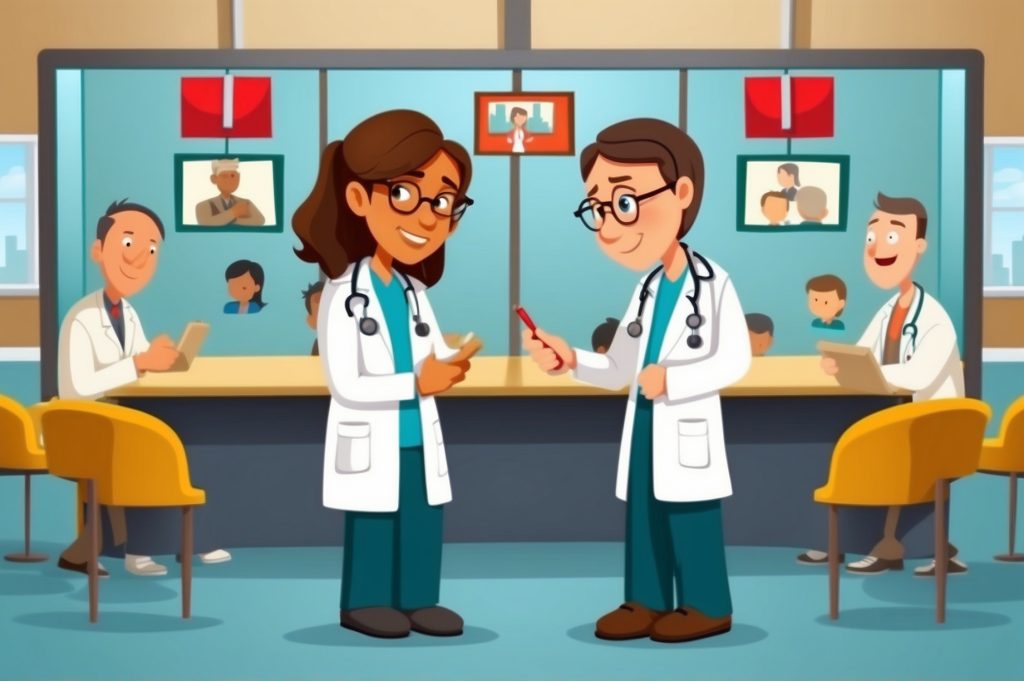
Dr Lynette Pretorius
Contact details
Dr Lynette Pretorius is an award-winning educator and researcher specialising in doctoral education, academic identity, student wellbeing, AI literacy, autoethnography, and research skills development.
Let’s talk about one of the most complex parts of research – understanding the philosophical underpinnings of your worldview and how this shapes the way your research is done. This is called a research paradigm and is one of the areas I get the most frequent questions about from graduate research students. The popularity of my research paradigm videos also show that this is clearly a concept that is difficult to understand and hard to articulate. So, in this blog post, I demystify what a research paradigm is, explore the most common research paradigms, demonstrate how a research paradigm influences the research process, and explain why it is important to articulate your paradigm in your research.
What is a research paradigm?
A research paradigm explains what you believe reality is and how you think knowledge can be understood. The technical terms used to articulate a research paradigm are ontology, epistemology, and axiology.
Ontology refers to the nature of reality. When people see reality as objective, it is called a realist ontology. When people see reality as subjective, it is called a relativist ontology. In other words, you need to explain whether you think reality is a singular, objective entity waiting to be discovered, or if it is a construct of individual experiences and perceptions.
Epistemology is concerned with the nature of knowledge and how we come to know something. There are three common epistemologies. First, reality can be objectively known if you can measure it with the right tools. Second, reality can only be partially known because it is created in the minds of individual people. Third, reality is always changing, so it is impossible to fully comprehend at any given moment.
Axiology deals with what is valued in research. It prompts us to consider how our own perspectives and values can shape the ways our research is designed and our findings are interpreted. In other words, you need to explain whether you think research should be value-free or whether you think research is value-laden. Do you think that steps should be taken to remove the researcher’s influence from the research, or is subjectivity inevitable?
What are the most common research paradigms?
I preface this discussion by noting that these are certainly not the only research paradigms that exist. Rather, these are just the ones that are most commonly found in research.
Positivism: Positivism is grounded in the belief that reality is singular and can be objectively observed and quantified. From this viewpoint, the researcher is independent of the subject of research, and knowledge is generated through empirical observation and measurement. Positivists believe that knowledge should be derived from empirical experience and logical reasoning, so they traditionally assert that research can and should be value-free.
Post-positivism: As the name suggests, this paradigm is closely related to positivism, having the same ontology and epistemology. However, post-positivists have a different axiology, arguing that complete objectivity is unattainable and that research cannot be entirely free from values, as choices about what to study, how to study it, and how findings are presented inevitably reflect value judgements. Consequently, they take steps to minimise the researcher’s influence in the way they design their studies by being reflexive about their own biases and the potential value implications of their work.
Constructivism: Constructivists believe that reality is subjective and that this reality can only be partially known because it is constructed in the minds of individual people. Constructivism emphasises that individuals’ realities are constructed through social interactions, so they seek to understand how individuals construct their realities and how these realities are influenced by social, cultural, and historical contexts. Constructivists embrace the value-laden nature of research, emphasising reflexivity and ethical responsibility, and valuing the co-construction of knowledge with participants. This paradigm acknowledges the subjective and interpretive nature of knowledge creation, viewing it as a strength that enriches understanding and contributes to the depth and authenticity of research findings. Constructivist researchers are also often concerned with the social implications of their research, seeking not only to understand the world but also to contribute positively towards social change.
Interpretivism: Interpretivists also believe reality is subjective and that reality can only be partially known because it is constructed in the minds of individual people. Interpretivism emphasises that individuals are the experts in their own experiences and focuses on understanding the subjective meanings and interpretations that individuals attach to their experiences. While interpretivism recognises the influence of researcher and participant values, it leans more towards understanding and interpreting the values and meanings inherent within the study context. Consequently, they believe that the researcher’s role is to immerse themselves in the participants’ experiences to gain a deep, empathetic understanding of their perspectives.
Pragmatism: Pragmatism is a flexible paradigm that suggests research methods should be chosen based on what best addresses the research question. Pragmatists believe reality is constantly changing or debated, so it does not commit to a single reality or method of inquiry. This allows for a mix of qualitative and quantitative methods. Pragmatism encourages an integrative approach to values, blending both subjective and objective perspectives. It recognises the importance of researchers’ and participants’ values and experiences in shaping research processes and outcomes. Yet, it also values objective evidence and the outcomes of research practices. This balance reflects pragmatism’s broader philosophical stance that truth and value are found in the practical implications of research and how it can address real-world problems.
Critical realism: Critical realists believe that an objective reality exists, but that it is layered, consisting of different levels that are not always observable. They believe our understanding of the world is subjective because it is influenced by societal and historical contexts and power relations. Critical realism is deeply intertwined with a commitment to understanding the world as it is, while also striving to transform it for the better. Critical realists believe that researchers bring their own beliefs, biases, and values to the research process, and urge researchers to critically reflect on and disclose their values and how these might impact their research.
I also recognise the importance of acknowledging that historically, some perspectives and bodies of knowledge have been overlooked or marginalised in research. This extends to the development and recognition of research paradigms as well. As such, I encourage you to also explore other diverse paradigms, especially those that may be considered ‘non-traditional’ or originate from non-Western contexts. Embracing a broader spectrum of paradigms can enrich our research approaches and outcomes, offering a wider range of valuable insights and perspectives.
How do research paradigms influence the research process?
Understanding and choosing a research paradigm is crucial because it shapes the entire research process—from framing the research question to deciding on methods, and interpreting the results. In essence, the research paradigm not only guides the technical aspects of study design, data collection, and analysis but also influences how researchers perceive and interact with their subject matter. It shapes the ethical considerations, the relationship with participants, and the ultimate goals of the research. By understanding and consciously choosing a research paradigm, researchers ensure that their work is coherent, meaningful, and aligned with their philosophical perspectives on reality, knowledge, and values. Let’s delve into how these philosophical underpinnings can shape each stage of the research process with some examples.
Formulating research questions
The paradigm a researcher adopts fundamentally shapes the nature of the questions they ask. For instance, in positivism, research questions are often framed to test hypotheses or measure variables, seeking to establish causal relationships or correlations. Constructivist, interpretivist, and critical realist paradigms, however, encourage questions that explore the meanings, experiences, and perceptions of participants, aiming to understand the complexity of human behaviour in particular contexts. These questions are then further refined based on the focus of the paradigm, leading to studies that focus on either societal change or a deeper understanding of lived experience. Pragmatism allows for flexibility, meaning research questions can be designed to solve specific problems, often leading to mixed-methods approaches.
Choosing methodologies and methods
The choice of methodologies and methods is also deeply influenced by the researcher’s paradigmatic stance. Positivists might lean towards structured methodologies that mimic the scientific method, employing quantitative measures such as surveys or experiments. Constructivists and interpretivists prefer qualitative methods like in-depth interviews, participant observation, or thematic analysis, which allow for a deep dive into participants’ lived experiences and the meanings they ascribe to them. Pragmatists select methods based on what best answers the research question, often combining qualitative and quantitative approaches in a pragmatic, problem-solving orientation. Critical realists might use a combination of qualitative and quantitative methods to explore both the surface phenomena and the underlying social or structural mechanisms contributing to these phenomena.
Data collection, analysis, and presentation of findings
Paradigms also dictate how data are collected and analysed, influencing the interaction with participants and the interpretation of data. Positivist approaches tend to emphasise objectivity and detachment, aiming for a neutral stance that minimises the researcher’s influence on the data. Findings are usually presented as objective truths or confirmed hypotheses, using statistical analysis to support conclusions. In contrast, constructivist and interpretivist paradigms view the researcher as a key instrument in the research process, engaging in reflective practices to interpret nuanced meanings within data, acknowledging their subjective influence. Findings are usually presented as insights into the participants’ perspectives, often narratively or through rich, descriptive accounts, emphasising the subjective nature of knowledge. The pragmatist paradigm focuses on practical outcomes, guiding the selection of data collection and analysis techniques that are most likely to produce actionable insights. Results are usually presented in a way that highlights their practical implications. The critical realist paradigm involves analysing data to identify not just what is happening but why it is happening, looking for patterns that reveal the influence of hidden structures or power relations. Findings are usually presented in a way which highlights or critiques the underlying societal mechanisms leading to a particular phenomenon.
Why is it important to explain your research paradigm?
Explaining the research paradigm in research publications or theses is pivotal for several reasons, each contributing to the clarity, integrity, and impact of the research. This explanation serves not just as a methodological formality but as a fundamental component that illuminates the researcher’s philosophical stance, guiding principles, and the rationale behind methodological choices. Here’s why delineating this paradigmatic foundation is crucial:
- Enhancing transparency and trustworthiness: Detailing the research paradigm enhances the transparency of the study, allowing readers to understand the foundational assumptions that underpin the research. This clarity helps peers, reviewers, and readers assess the rigour or trustworthiness of the research process and its findings because it allows for an assessment of how well the research design, methodology, and methods align with the paradigmatic assumptions.
- Justifying methodological choices: As noted above, the research paradigm informs the researcher’s methodological choices. By explaining this in their publications or theses, researchers provide a rationale for their methodological decisions. This explanation helps readers understand why certain methods were chosen over others and how these choices are consistent with the researcher’s philosophical stance, enhancing the coherence and integrity of the study.
- Aiding interpretation of findings: Understanding the paradigmatic perspective of a study aids in the interpretation of its findings. Different paradigms can lead to different interpretations of the same phenomenon. By stating their research paradigm, researchers help readers place the findings within the appropriate conceptual and philosophical framework, ensuring that interpretations are made with an understanding of the underlying assumptions.
- Contributing to disciplinary dialogue: The explicit articulation of research paradigms contributes to ongoing disciplinary dialogue and debate about the nature of reality and knowledge construction in a field. It encourages reflexivity among researchers, prompting them to consider and articulate their own positions. This reflexivity enriches the field by fostering a diversity of perspectives and approaches, leading to a more robust and dynamic academic discourse.
- Helping others build upon your study: For those looking to replicate or build upon a study, understanding its paradigmatic underpinnings is essential. It ensures that subsequent research is grounded in the same philosophical assumptions, or consciously diverges from them, maintaining a level of methodological consistency and rigour across studies.
So in summary, understanding and explaining your research paradigms in publications or theses is not merely a theoretical exercise but a practical necessity that underpins the trustworthiness, clarity, and impact of research. It serves as a bridge connecting the philosophical foundations of a study with its practical execution and interpretation, enriching both the research process and its contributions to knowledge.
To cite this article, you can use this reference: Pretorius, L. (2024). Demystifying research paradigms: Navigating ontology, epistemology, and axiology in research. The Qualitative Report, 29(10), 2698-2715. https://doi.org/10.46743/2160-3715/2024.7632
Questions to ponder
Should research be value-free or is it value-laden?
In what ways do your ontology, epistemology, and axiology shape the way you conduct research?
Consider a recent study you’ve encountered. What research paradigm does it seem to align with, and how did this influence its findings and conclusions?














27 Comments